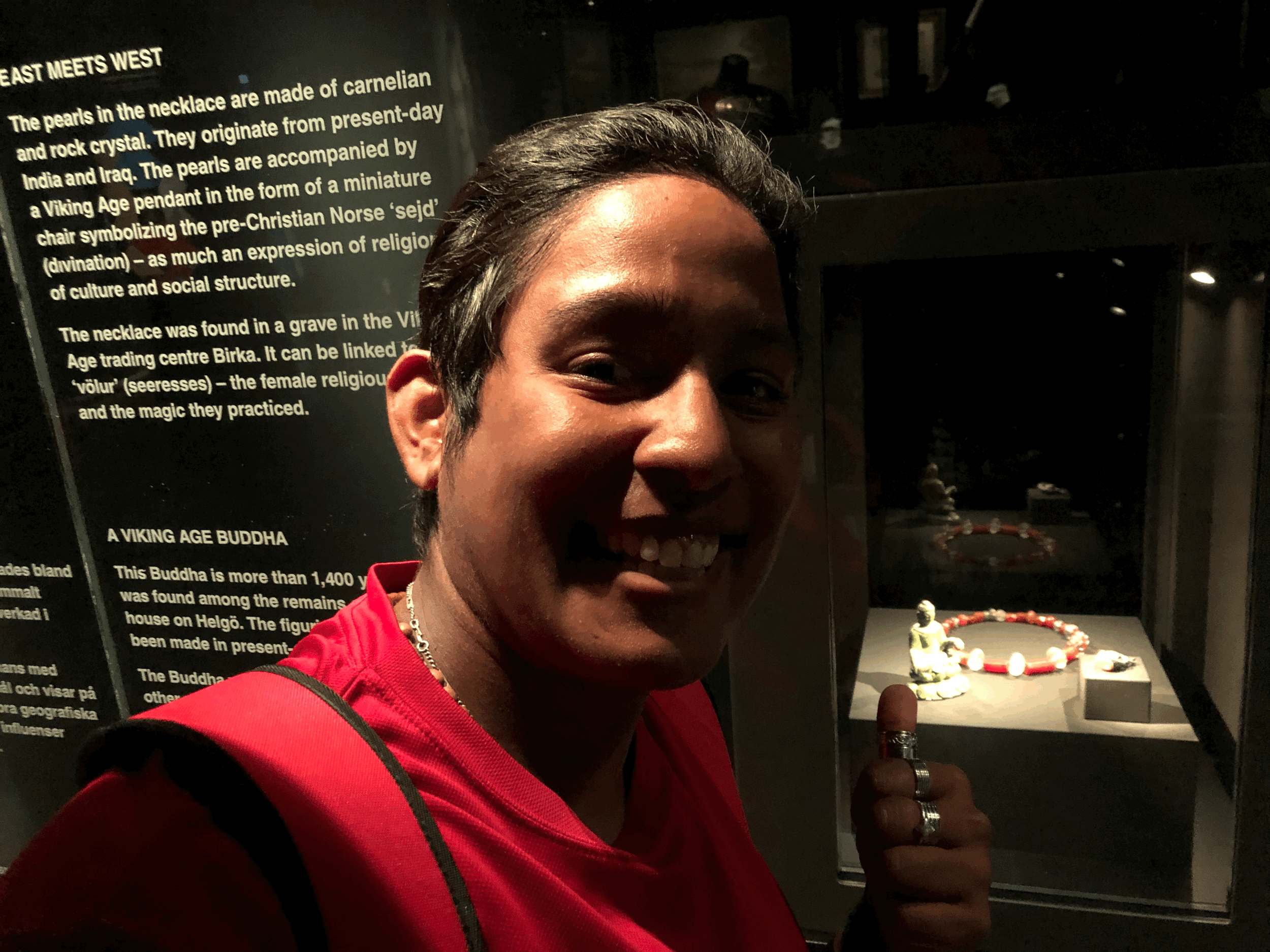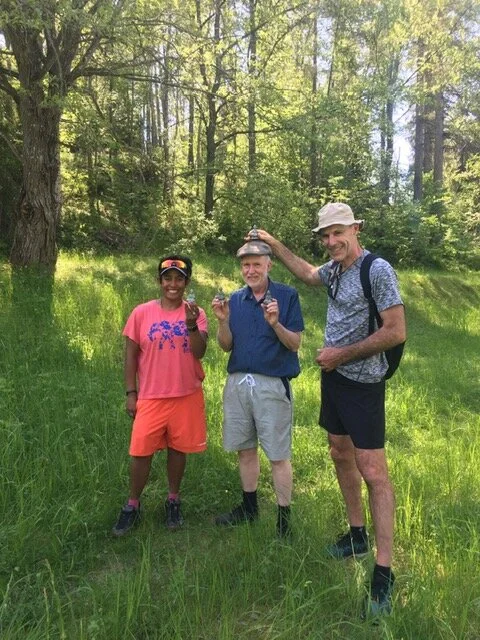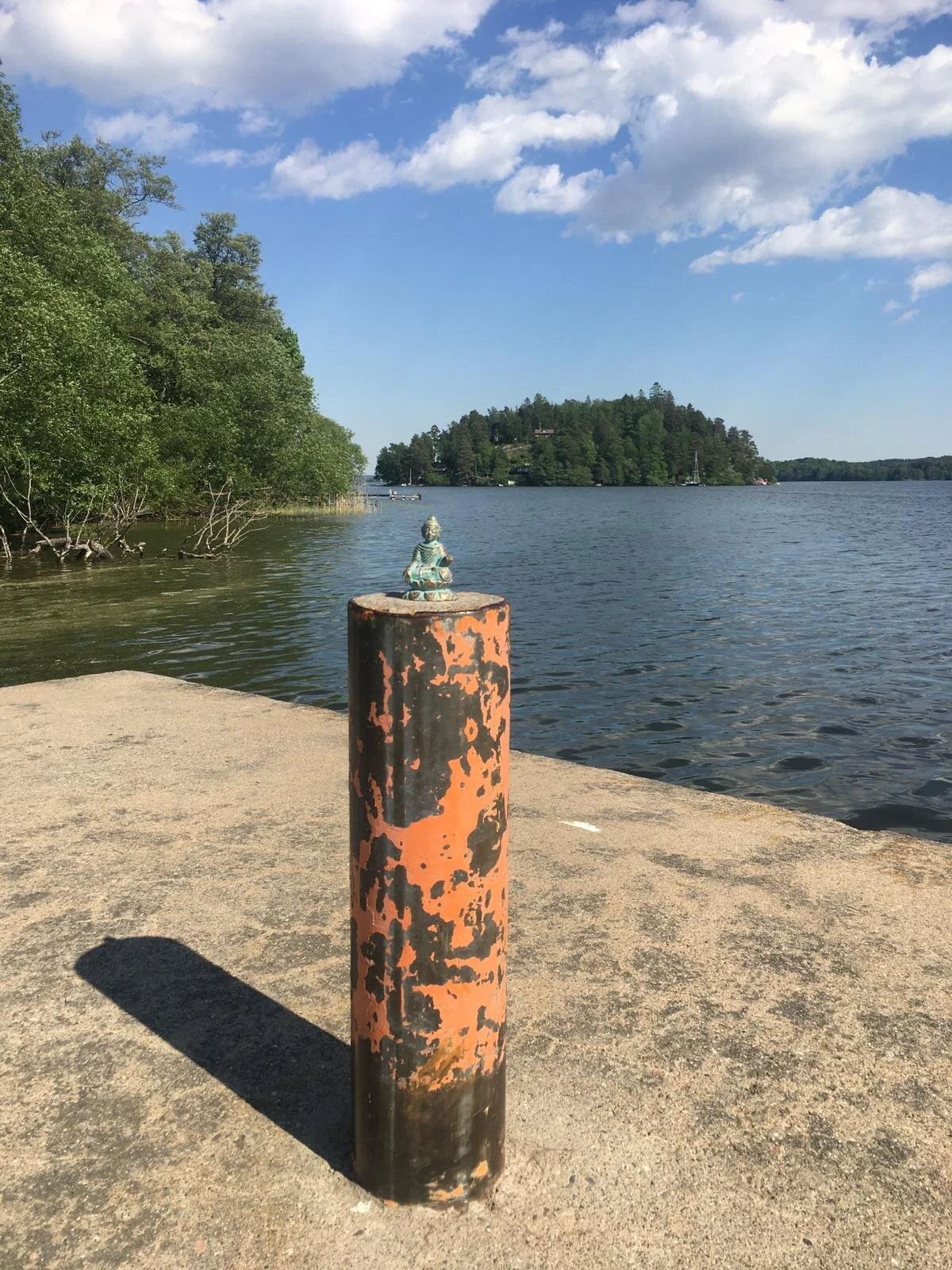Helgö - the Holy Island
This account of the replica Helgö Buddha statue’s travels begins on the fifth of June 2021, from the exact location on the Swedish island of Helgö where the statue was discovered in 1956 during archaeological excavations. The spot where the Helgö Buddha was found buried now lies in the middle of a beautiful meadow with long green grass surrounded by large broad leaved trees providing shade on this warm early summer day. Linda had just concluded the guided tour of the archaeological sites of Helgö and we had arrived at the location that from now and onwards would be referred to as the starting point of the journey this replica statue. In fact the author of this piece and their two travel companions, Josefa and Jac, each carried their own statue.
This was a special moment, which occurred more than a year after we first became aware of the statue’s existence and could admire the original, which was exhibited at the Swedish History Museum.
Josefa and the Helgö Buddha exhibited at the Swedish History Museum in 2020.
Of course, there were the obligatory photos taken of the three of us at the very spot of the statue’s discovery.
Josefa, Per and Jac at the spot on Helgö where the Buddha statue was found in 1956.
On that same day, the statue also paid a visit to the hill fort, the highest point of the Helgö island, then on to the jetty on the island’s south-western side, from where it would set off on its travel to other parts of the world.
It is mind boggling to imagine that Helgö was one of the most important islands and trade settlements around the Mälaren Valley, an unofficial region encompassing the now modern counties of Stockholm, Uppsala, Södermanland, Örebro and Västmanland in the east of Sweden, during the Viking era, 1,200 years ago. There were no visible traces of that history until 1954, when a Swede dug a hole in the ground in the land around his summer house to erect a flag pole and discovered a bronze ladle. Nature had effectively covered up all evidence of the Viking settlement. It is even more amazing that a small Buddha statue from northern India was found buried in the soil of this island. After undertaking extensive research, myself and my intrepid travel companions have not come across any other case of a Buddha statue ending up in current Europe, before or during the Viking period.
The water body on the eastern side of Helgö has been reduced since the Viking age due to post glacial land uplift. Only small boats can now navigate the narrow strait, with thick vegetation of common reed, separating the island from neighbouring Ekerö. During the Viking period, the protected bays in this area made for ideal harbours. The major waterway from Stockholm into Lake Mälaren, Bockholmssundet, runs immediately west of Helgö. During our visit to Helgö, we walked the five hundred metres from the main road to the southern jetty. After inspecting the structure, Jac concluded that it was feasible to moor his boat against it. Thus, this would allow transport of the Buddha statue from and to the Helgö island.
A small jetty close to the southern tip of the Helgö island.
Helgö - the forgotten island, as it is sometimes referred to as, is quickly becoming a favoured residential area in a spectacular natural setting, close to Stockholm, the capital city of the country, and thus a home to a rapidly growing population. Many of the residents may not even be aware of the very special history of Helgö island. It seems to deserve a lot more attention than it has so far received. Unless you are aware of the archaeological studies, it is near impossible to get a good understanding of the Viking era settlements. There are a couple of nicely presented information boards in a few locations but, without a knowledgeable guide, the insight gained during a visit would be limited. Considering that Helgö, for hundreds of years, was maybe the most important settlement in the area around Lake Mälaren, before Birka rose to prominence, it represents a rather low-key and underwhelming display of the history of Helgö.
In one sense, Helgö is in sharp contrast with Birka, which is a major tourist attraction with its own museum, a built-up Viking village, regular guided tours and other activities, which during the summer can be reached by a daily one hour boat trip from the centre of Stockholm, which incidentally passes next to Helgö. The tourist attractions created at Birka are part of a private initiative and funding and not a historic preservation effort by the government. Reference to Helgö as the ‘forgotten island’ therefore seems to be a very appropriate description of the island. The lack of extensive information for visitors on Helgö is somewhat intriguing. One reason for this may be that the archaeological excavations have been undertaken on vacant land next to plots occupied by Swedes’ summer houses, their simply properties that are their summer escape from the city which occupy most of the area. It may be difficult to arrange an exhibition or display without potentially disturbing the nearby residents. The Helgö story is though a fascinating one and taken together with Birka and Sigtuna, there seems to be a an exciting and worthwhile opportunity to combine a tour of all three Viking towns/settlements, Birka, Sigtuna and Helgö which are all situated in Lake Mälaren and can be reached by boat. The Viking period is of interest to many people, not only in Sweden but also internationally as the impact of the Vikings extended to many parts of Europe, the Baltics, Russia and far beyond.


